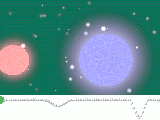Mariner 10 mission
A moon of Mercury was for a short time thought to exist. On March 27, 1974, two days before Mariner 10 made its flyby of Mercury, instruments began registering large amounts of ultraviolet radiation in the vicinity of Mercury that, according to one astronomer, "had no right to be there". [1] By the next day, the radiation had disappeared; it reappeared three days later, appearing to originate from an object that was, seemingly, detached from Mercury. [1] Some astronomers speculated that they had detected a star, but others argued that the object must be a moon, citing not only the two different directions from which the radiation had emanated but also the belief that such high-energy radiation could not penetrate very far through the interstellar medium. [1] Arguments in favor of a moon were strengthened when the object's speed was calculated to be 4 kilometres per second (2.5 mi/s), which matched the expected speed of a moon. [1]
31 Crateris

A "moon" was detected moving away from Mercury in 1974, and was eventually identified as a background star, 31 Crateris. 31 Crateris is a spectroscopic binary with a period of 2.9 days, and this may have been the source of the ultraviolet radiation detected in 1974. [6] The 'moon of Mercury' misidentification in 1974 sparked an important discovery in astronomy: ultraviolet radiation is not as completely absorbed by the interstellar medium as was formerly thought.
